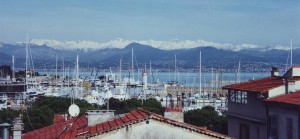In March 1999 Peer Holm Jørgensen, after teminating his service as president of a French industial company, decided to leave the business world at age 53, as he sInce 1980 had worked as a manager and business adviser in Denmark and Europe.
Based on his experiences with the French labor standards he decided to do a book about his four years in France. In 2000 “Back-log” (Aschehoug, Copenhagen) was released.
In 2006 Peer had moved to Denmark and had formed his own publishing house ISOTIA to publish books written by upcoming authors. Already early 2007 the first writer-in-spee, Jackline Alaka Buluma of Kenya, entered.
ISOTIA is an acronym of the Danish sentence: “I Solen Over Tagene I Antibes”. In English it would be: “In the Sun Over The roofs of Antibes.”
The name is to honor a very remarkable lady, who Peer came to meet by chance in May 1996, when the lady was in her late 80s. Peer was visiting a friend in Antibes, Southern France. At a time the friend pointed out between the roof tops and said: “The old lady is ready to sell.”
 It appeared the friend was right. “The old lady” was ready to sell. However, one condition applied: To buy Peer was obliged to visit her in her home in Denmark to hear her story.
It appeared the friend was right. “The old lady” was ready to sell. However, one condition applied: To buy Peer was obliged to visit her in her home in Denmark to hear her story.
The view from where ISOTIA was born.
Antibes, Southern France. Click on it to enlarge.
When meeting her for lunch in her old traditional Danish three wing farmhouse, she among other told Peer:
“I was married to a very kind and generous man. However, he was a member of the Nazi community. However, during the second World War I was hiding members of the resistance movement on the loft, while he had meetings with his Nazi friends, right here in this room, I had to divorce him. He was really a very kind man. But, you have to understand it could never work between us with the conditions we were in.”
She had had to escape to neighboring neutral Sweden for the rest of the war. Here she and her sons survived by collecting newspapers for recycling until they could return safely to Denmark, where she opened a recycling company still in business today.
When she put a jam jar on the table asking, if Peer could tell what it was, it just completed the picture of an extraordinary lady. It was nothing but pure gold. In the 70s and early 80s she had made a living from collecting used key boards to take out the gold, which those days was used under keys as contacts.
As she used to refer to her apartment in Antibes as “a little spot in the sun” what would then, with her story, be better than paying her respect by creating the name ISOTIA?
When ISOTIA was about to publish its second novel in 2007 the Danish book-market changed dramatically from being well organized since the 1850s to be nothing other than being pure Wild West. The book stores, as we knew them, closed one by one and those left became reluctant to make any efforts for new comers.
Peer decided to change full focus on supporting up coming writers and created ISOTIA Writing Concept. At the same time Peer was addressed by Magne Hovden, Ancoral Literary Agency, asking if Peer would be interested in publishing some works in Denmark. Peer refused. However, Magne took on one of Peer’s books “The Forgotten Massacre” to try to sell the rights abroad. In 2009 it was published in Bahasa Indonesia.
Today ISOTIA focus in full to support writers who comply with our philosophy, the concept and our mission.
In the future, starting with “The Missing History” to be follow by “The Kenyan Pilgrim – book one” to further titles, all revealing true stories, with the purpose that the future should be based on the past through present actions.
Our mission is to get the true story told by the people for the people.
The logo symbolizes a flower. It was created in 1980 by Peer and has since been polished by Friedrich Joost.